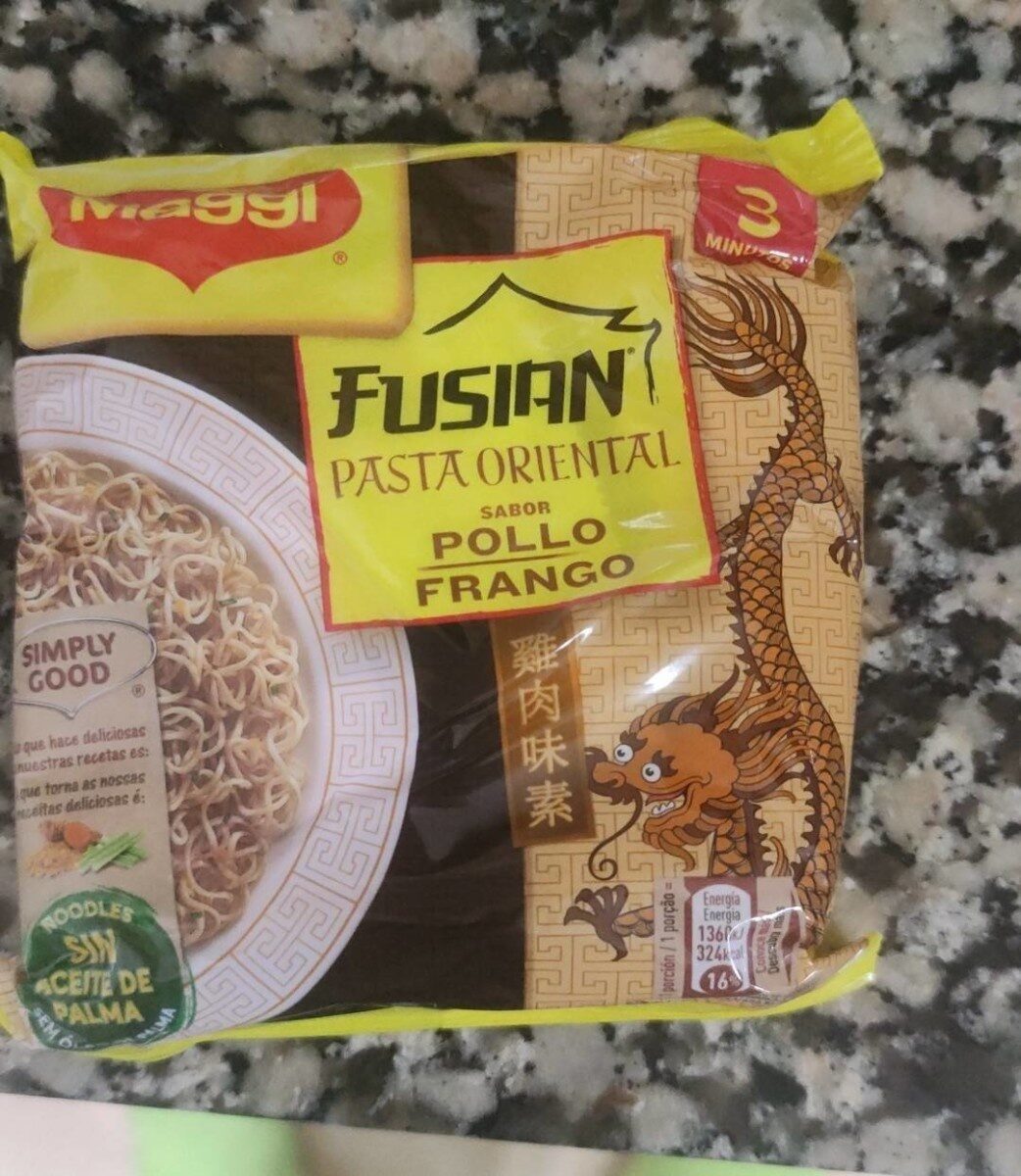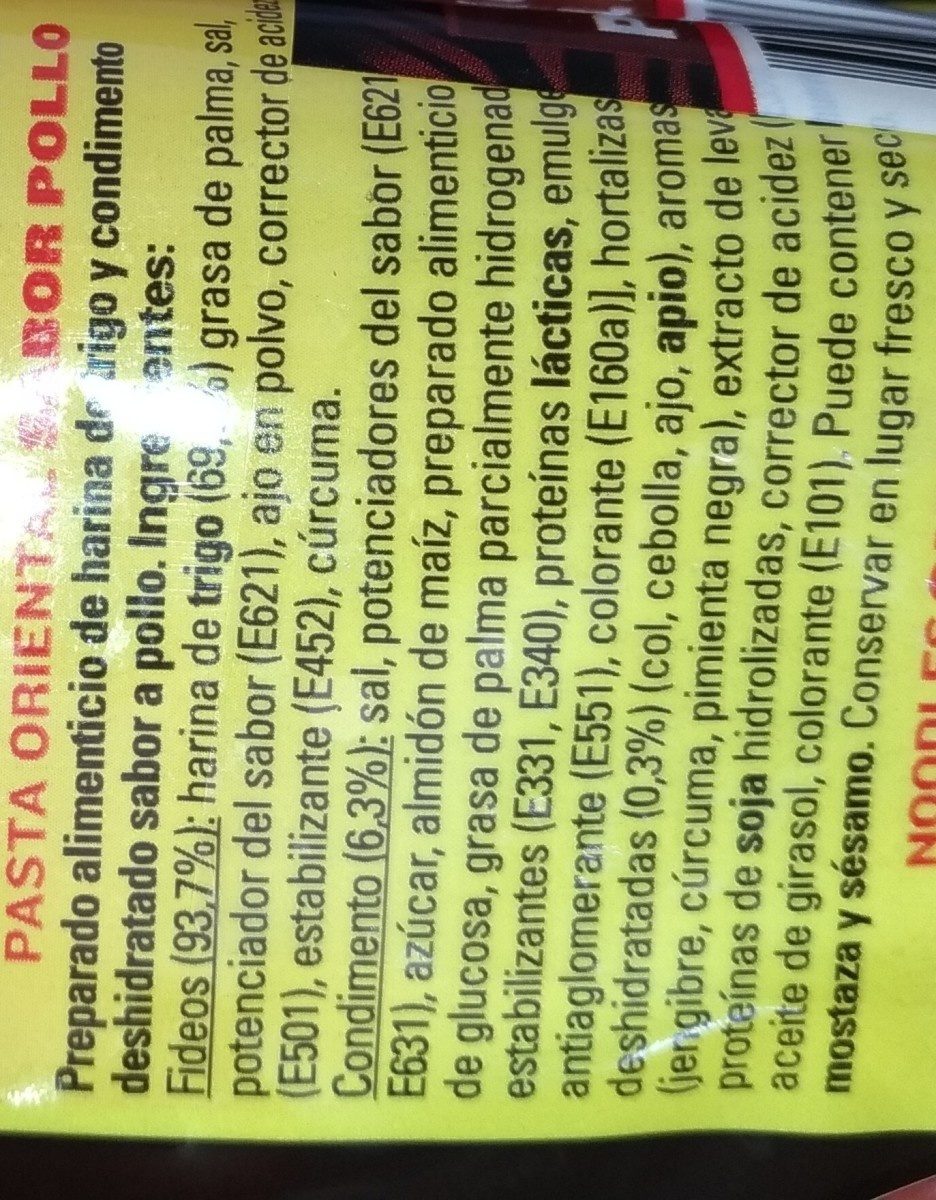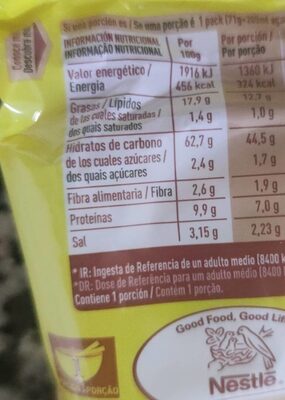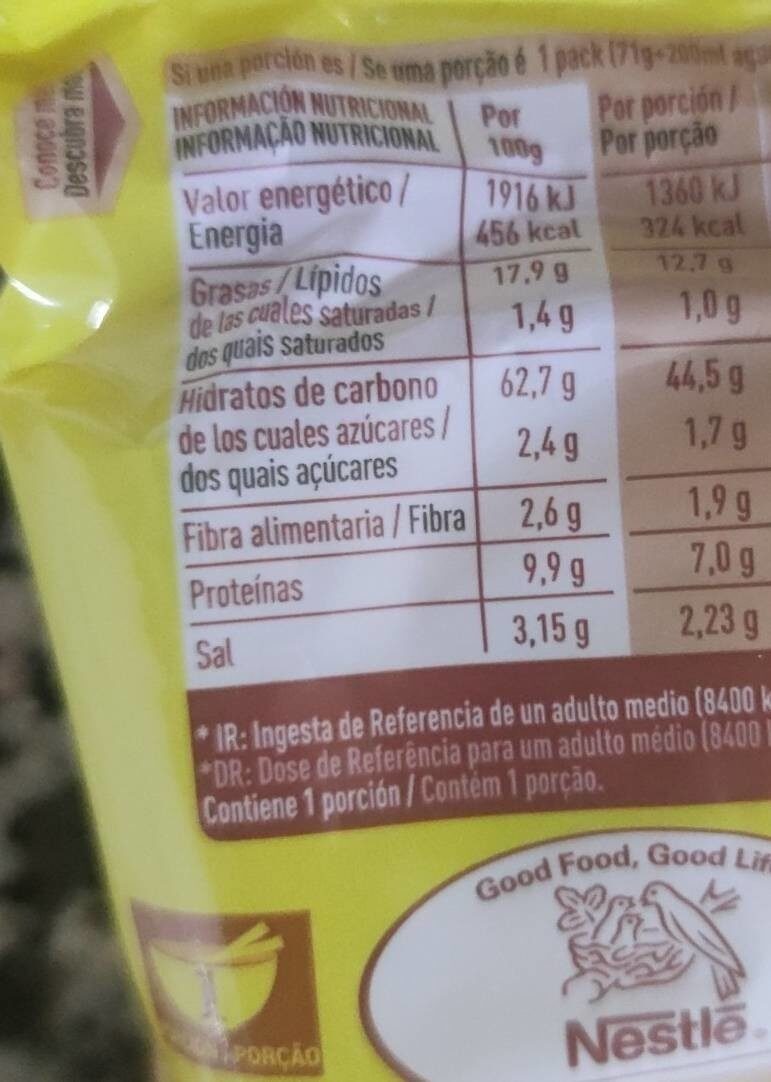Help us make food transparency the norm!
As a non-profit organization, we depend on your donations to continue informing consumers around the world about what they eat.
The food revolution starts with you!
Fusian Pasta Oriental-sabor pollo - Maggi
Fusian Pasta Oriental-sabor pollo - Maggi
This product page is not complete. You can help to complete it by editing it and adding more data from the photos we have, or by taking more photos using the app for Android or iPhone/iPad. Thank you!
×
Barcode: 7613035864924 (EAN / EAN-13)
Brands: Maggi
Categories: Plant-based foods and beverages, Plant-based foods, Cereals and potatoes, Cereals and their products, Pastas, Tagliatelle
Countries where sold: France
Matching with your preferences
Health
Ingredients
-
41 ingredients
: BOR POLLO PASTA ORIENTA Preparado alimenticio de harina de arigo y condimento deshidratado sabor a pollo. Ingre entes: Fideos (93.7%): harina de trigo (69, ) grasa de palma, al, potenciador del sabor (E621), ajo en polvo, corrector de aci (E501), estabilizante (E452), cúrcuma. Condimento (6,3%); sal, potenciadores del sabor (E621 E631), azúcar, almidón de maíz, preparado alimenticio de glucosa, grasa de palma parcialmente hidrogenad estabilizantes (E331, E340), proteínas lácticas, emulge antiaglomerante (E551), colorante (E160a)], hortalizas deshidratadas (0,3%) (col, cebolla, ajo, apio), aromas (jer.gibre, cúrcuma, pimienta negra), extracto de leve proteínas de soja hidrolizadas, corrector de acidez aceite de girasol, colorante (E101). Puede contener mostaza y sésamo. Conservar en lugar fresco y secAllergens: Celery, GlutenTraces: Mustard, Sesame seeds
Food processing
-
Ultra processed foods
Elements that indicate the product is in the 4 - Ultra processed food and drink products group:
- Additive: E101 - Riboflavin
- Additive: E160a - Carotene
- Additive: E452 - Polyphosphates
- Additive: E551 - Silicon dioxide
- Additive: E621 - Monosodium glutamate
- Additive: E631 - Disodium inosinate
- Ingredient: Colour
- Ingredient: Flavour enhancer
- Ingredient: Flavouring
Food products are classified into 4 groups according to their degree of processing:
- Unprocessed or minimally processed foods
- Processed culinary ingredients
- Processed foods
- Ultra processed foods
The determination of the group is based on the category of the product and on the ingredients it contains.
Additives
-
E101 - Riboflavin
Riboflavin: Riboflavin, also known as vitamin B2, is a vitamin found in food and used as a dietary supplement. Food sources include eggs, green vegetables, milk and other dairy product, meat, mushrooms, and almonds. Some countries require its addition to grains. As a supplement it is used to prevent and treat riboflavin deficiency and prevent migraines. It may be given by mouth or injection.It is nearly always well tolerated. Normal doses are safe during pregnancy. Riboflavin is in the vitamin B group. It is required by the body for cellular respiration.Riboflavin was discovered in 1920, isolated in 1933, and first made in 1935. It is on the World Health Organization's List of Essential Medicines, the most effective and safe medicines needed in a health system. Riboflavin is available as a generic medication and over the counter. In the United States a month of supplements costs less than 25 USD.Source: Wikipedia
-
E160a - Carotene
Carotene: The term carotene -also carotin, from the Latin carota, "carrot"- is used for many related unsaturated hydrocarbon substances having the formula C40Hx, which are synthesized by plants but in general cannot be made by animals -with the exception of some aphids and spider mites which acquired the synthesizing genes from fungi-. Carotenes are photosynthetic pigments important for photosynthesis. Carotenes contain no oxygen atoms. They absorb ultraviolet, violet, and blue light and scatter orange or red light, and -in low concentrations- yellow light. Carotenes are responsible for the orange colour of the carrot, for which this class of chemicals is named, and for the colours of many other fruits, vegetables and fungi -for example, sweet potatoes, chanterelle and orange cantaloupe melon-. Carotenes are also responsible for the orange -but not all of the yellow- colours in dry foliage. They also -in lower concentrations- impart the yellow coloration to milk-fat and butter. Omnivorous animal species which are relatively poor converters of coloured dietary carotenoids to colourless retinoids have yellowed-coloured body fat, as a result of the carotenoid retention from the vegetable portion of their diet. The typical yellow-coloured fat of humans and chickens is a result of fat storage of carotenes from their diets. Carotenes contribute to photosynthesis by transmitting the light energy they absorb to chlorophyll. They also protect plant tissues by helping to absorb the energy from singlet oxygen, an excited form of the oxygen molecule O2 which is formed during photosynthesis. β-Carotene is composed of two retinyl groups, and is broken down in the mucosa of the human small intestine by β-carotene 15‚15'-monooxygenase to retinal, a form of vitamin A. β-Carotene can be stored in the liver and body fat and converted to retinal as needed, thus making it a form of vitamin A for humans and some other mammals. The carotenes α-carotene and γ-carotene, due to their single retinyl group -β-ionone ring-, also have some vitamin A activity -though less than β-carotene-, as does the xanthophyll carotenoid β-cryptoxanthin. All other carotenoids, including lycopene, have no beta-ring and thus no vitamin A activity -although they may have antioxidant activity and thus biological activity in other ways-. Animal species differ greatly in their ability to convert retinyl -beta-ionone- containing carotenoids to retinals. Carnivores in general are poor converters of dietary ionone-containing carotenoids. Pure carnivores such as ferrets lack β-carotene 15‚15'-monooxygenase and cannot convert any carotenoids to retinals at all -resulting in carotenes not being a form of vitamin A for this species-; while cats can convert a trace of β-carotene to retinol, although the amount is totally insufficient for meeting their daily retinol needs.Source: Wikipedia
-
E331 - Sodium citrates
Sodium citrate: Sodium citrate may refer to any of the sodium salts of citrate -though most commonly the third-: Monosodium citrate Disodium citrate Trisodium citrateThe three forms of the salt are collectively known by the E number E331. Sodium citrates are used as acidity regulators in food and drinks, and also as emulsifiers for oils. They enable cheeses to melt without becoming greasy.Source: Wikipedia
-
E340 - Potassium phosphates
Potassium phosphate: Potassium phosphate is a generic term for the salts of potassium and phosphate ions including: Monopotassium phosphate -KH2PO4- -Molar mass approx: 136 g/mol- Dipotassium phosphate -K2HPO4- -Molar mass approx: 174 g/mol- Tripotassium phosphate -K3PO4- -Molar mass approx: 212.27 g/mol-As food additives, potassium phosphates have the E number E340.Source: Wikipedia
-
E501 - Potassium carbonates
Potassium carbonate: Potassium carbonate -K2CO3- is a white salt, which is soluble in water -insoluble in ethanol- and forms a strongly alkaline solution. It can be made as the product of potassium hydroxide's absorbent reaction with carbon dioxide. It is deliquescent, often appearing a damp or wet solid. Potassium carbonate is used in the production of soap and glass.Source: Wikipedia
-
E551 - Silicon dioxide
Silicon dioxide: Silicon dioxide, also known as silica, silicic acid or silicic acid anydride is an oxide of silicon with the chemical formula SiO2, most commonly found in nature as quartz and in various living organisms. In many parts of the world, silica is the major constituent of sand. Silica is one of the most complex and most abundant families of materials, existing as a compound of several minerals and as synthetic product. Notable examples include fused quartz, fumed silica, silica gel, and aerogels. It is used in structural materials, microelectronics -as an electrical insulator-, and as components in the food and pharmaceutical industries. Inhaling finely divided crystalline silica is toxic and can lead to severe inflammation of the lung tissue, silicosis, bronchitis, lung cancer, and systemic autoimmune diseases, such as lupus and rheumatoid arthritis. Uptake of amorphous silicon dioxide, in high doses, leads to non-permanent short-term inflammation, where all effects heal.Source: Wikipedia
-
E621 - Monosodium glutamate
Monosodium glutamate: Monosodium glutamate -MSG, also known as sodium glutamate- is the sodium salt of glutamic acid, one of the most abundant naturally occurring non-essential amino acids. Glutamic acid is found naturally in tomatoes, grapes, cheese, mushrooms and other foods.MSG is used in the food industry as a flavor enhancer with an umami taste that intensifies the meaty, savory flavor of food, as naturally occurring glutamate does in foods such as stews and meat soups. It was first prepared in 1908 by Japanese biochemist Kikunae Ikeda, who was trying to isolate and duplicate the savory taste of kombu, an edible seaweed used as a base for many Japanese soups. MSG as a flavor enhancer balances, blends, and rounds the perception of other tastes.The U.S. Food and Drug Administration has given MSG its generally recognized as safe -GRAS- designation. A popular belief is that large doses of MSG can cause headaches and other feelings of discomfort, known as "Chinese restaurant syndrome," but double-blind tests fail to find evidence of such a reaction. The European Union classifies it as a food additive permitted in certain foods and subject to quantitative limits. MSG has the HS code 29224220 and the E number E621.Source: Wikipedia
-
E631 - Disodium inosinate
Disodium inosinate: Disodium inosinate -E631- is the disodium salt of inosinic acid with the chemical formula C10H11N4Na2O8P. It is used as a food additive and often found in instant noodles, potato chips, and a variety of other snacks. Although it can be obtained from bacterial fermentation of sugars, it is often commercially prepared from animal sources.Source: Wikipedia
Ingredients analysis
-
Palm oil
Ingredients that contain palm oil: Palm fat
-
Vegan status unknown
Unrecognized ingredients: es:bor-pollo-pasta-orienta-preparado-alimenticio-de-harina-de-arigo-y-condimento-deshidratado-sabor-a-pollo, es:ingre-entes, es:69, es:al, es:corrector-de-aci, es:preparado-alimenticio-de-glucosa, es:grasa-de-palma-parcialmente-hidrogenad-estabilizantes, es:proteinas-lacticas, es:emulge-antiaglomerante, es:jer-gibre, es:extracto-de-leve-proteinas-de-soja-hidrolizadas, es:corrector-de-acidez-aceite-de-girasol, es:conservar-en-lugar-fresco-y-secSome ingredients could not be recognized.
We need your help!
You can help us recognize more ingredients and better analyze the list of ingredients for this product and others:
- Edit this product page to correct spelling mistakes in the ingredients list, and/or to remove ingredients in other languages and sentences that are not related to the ingredients.
- Add new entries, synonyms or translations to our multilingual lists of ingredients, ingredient processing methods, and labels.
If you would like to help, join the #ingredients channel on our Slack discussion space and/or learn about ingredients analysis on our wiki. Thank you!
-
Vegetarian status unknown
Unrecognized ingredients: es:bor-pollo-pasta-orienta-preparado-alimenticio-de-harina-de-arigo-y-condimento-deshidratado-sabor-a-pollo, es:ingre-entes, es:69, es:al, es:corrector-de-aci, es:preparado-alimenticio-de-glucosa, es:grasa-de-palma-parcialmente-hidrogenad-estabilizantes, es:proteinas-lacticas, es:emulge-antiaglomerante, es:jer-gibre, es:extracto-de-leve-proteinas-de-soja-hidrolizadas, es:corrector-de-acidez-aceite-de-girasol, es:conservar-en-lugar-fresco-y-secSome ingredients could not be recognized.
We need your help!
You can help us recognize more ingredients and better analyze the list of ingredients for this product and others:
- Edit this product page to correct spelling mistakes in the ingredients list, and/or to remove ingredients in other languages and sentences that are not related to the ingredients.
- Add new entries, synonyms or translations to our multilingual lists of ingredients, ingredient processing methods, and labels.
If you would like to help, join the #ingredients channel on our Slack discussion space and/or learn about ingredients analysis on our wiki. Thank you!
-
Details of the analysis of the ingredients
We need your help!
Some ingredients could not be recognized.
We need your help!
You can help us recognize more ingredients and better analyze the list of ingredients for this product and others:
- Edit this product page to correct spelling mistakes in the ingredients list, and/or to remove ingredients in other languages and sentences that are not related to the ingredients.
- Add new entries, synonyms or translations to our multilingual lists of ingredients, ingredient processing methods, and labels.
If you would like to help, join the #ingredients channel on our Slack discussion space and/or learn about ingredients analysis on our wiki. Thank you!
: BOR POLLO PASTA ORIENTA Preparado alimenticio de harina de arigo y condimento deshidratado sabor a pollo, Ingre entes (Fideos), harina de trigo (69), grasa de palma, al, potenciador del sabor (e621), ajo, corrector de aci (e501), estabilizante (e452), cúrcuma, Condimento 6.3%, sal, potenciadores del sabor (e621, e631), azúcar, almidón de maíz, preparado alimenticio de glucosa, grasa de palma parcialmente hidrogenad estabilizantes (e331, e340), proteínas lácticas, emulge antiaglomerante (e551), colorante (e160a), hortalizas 0.3%, aromas (jer.gibre, cúrcuma, pimienta negra), extracto de leve proteínas de soja hidrolizadas, corrector de acidez aceite de girasol, colorante (e101), Conservar en lugar fresco y sec- BOR POLLO PASTA ORIENTA Preparado alimenticio de harina de arigo y condimento deshidratado sabor a pollo -> es:bor-pollo-pasta-orienta-preparado-alimenticio-de-harina-de-arigo-y-condimento-deshidratado-sabor-a-pollo
- Ingre entes -> es:ingre-entes
- Fideos -> en:noodle - vegan: maybe - vegetarian: maybe
- harina de trigo -> en:wheat-flour - vegan: yes - vegetarian: yes - ciqual_proxy_food_code: 9410
- 69 -> es:69
- grasa de palma -> en:palm-fat - vegan: yes - vegetarian: yes - from_palm_oil: yes - ciqual_proxy_food_code: 16129
- al -> es:al
- potenciador del sabor -> en:flavour-enhancer
- e621 -> en:e621 - vegan: yes - vegetarian: yes
- ajo -> en:garlic - vegan: yes - vegetarian: yes - ciqual_food_code: 11000
- corrector de aci -> es:corrector-de-aci
- e501 -> en:e501 - vegan: yes - vegetarian: yes
- estabilizante -> en:stabiliser
- e452 -> en:e452 - vegan: yes - vegetarian: yes
- cúrcuma -> en:turmeric - vegan: yes - vegetarian: yes - ciqual_proxy_food_code: 11089
- Condimento -> en:condiment - vegan: maybe - vegetarian: maybe - percent: 6.3
- sal -> en:salt - vegan: yes - vegetarian: yes - ciqual_food_code: 11058
- potenciadores del sabor -> en:flavour-enhancer
- e621 -> en:e621 - vegan: yes - vegetarian: yes
- e631 -> en:e631 - vegan: maybe - vegetarian: maybe
- azúcar -> en:sugar - vegan: yes - vegetarian: yes - ciqual_proxy_food_code: 31016
- almidón de maíz -> en:corn-starch - vegan: yes - vegetarian: yes - ciqual_food_code: 9510
- preparado alimenticio de glucosa -> es:preparado-alimenticio-de-glucosa
- grasa de palma parcialmente hidrogenad estabilizantes -> es:grasa-de-palma-parcialmente-hidrogenad-estabilizantes
- e331 -> en:e331 - vegan: yes - vegetarian: yes
- e340 -> en:e340 - vegan: yes - vegetarian: yes
- proteínas lácticas -> es:proteinas-lacticas
- emulge antiaglomerante -> es:emulge-antiaglomerante
- e551 -> en:e551 - vegan: yes - vegetarian: yes
- colorante -> en:colour
- e160a -> en:e160a - vegan: maybe - vegetarian: maybe - from_palm_oil: maybe
- hortalizas -> en:vegetable - vegan: yes - vegetarian: yes - percent: 0.3
- aromas -> en:flavouring - vegan: maybe - vegetarian: maybe
- jer.gibre -> es:jer-gibre
- cúrcuma -> en:turmeric - vegan: yes - vegetarian: yes - ciqual_proxy_food_code: 11089
- pimienta negra -> en:black-pepper - vegan: yes - vegetarian: yes - ciqual_food_code: 11015
- extracto de leve proteínas de soja hidrolizadas -> es:extracto-de-leve-proteinas-de-soja-hidrolizadas
- corrector de acidez aceite de girasol -> es:corrector-de-acidez-aceite-de-girasol
- colorante -> en:colour
- e101 -> en:e101 - vegan: maybe - vegetarian: yes
- Conservar en lugar fresco y sec -> es:conservar-en-lugar-fresco-y-sec
Nutrition
-
Poor nutritional quality
⚠ ️Warning: the amount of fruits, vegetables and nuts is not specified on the label, it was estimated from the list of ingredients: 0This product is not considered a beverage for the calculation of the Nutri-Score.
Positive points: 2
- Proteins: 5 / 5 (value: 9.9, rounded value: 9.9)
- Fiber: 2 / 5 (value: 2.6, rounded value: 2.6)
- Fruits, vegetables, nuts, and colza/walnut/olive oils: 0 / 5 (value: 0.3, rounded value: 0.3)
Negative points: 15
- Energy: 5 / 10 (value: 1908, rounded value: 1908)
- Sugars: 0 / 10 (value: 2.4, rounded value: 2.4)
- Saturated fat: 10 / 10 (value: 14, rounded value: 14)
- Sodium: 0 / 10 (value: 0, rounded value: 0)
The points for proteins are not counted because the negative points are greater or equal to 11.
Nutritional score: (15 - 2)
Nutri-Score:
-
Nutrient levels
-
Fat in moderate quantity (17.9%)
What you need to know- A high consumption of fat, especially saturated fats, can raise cholesterol, which increases the risk of heart diseases.
Recommendation: Limit the consumption of fat and saturated fat- Choose products with lower fat and saturated fat content.
-
Saturated fat in high quantity (14%)
What you need to know- A high consumption of fat, especially saturated fats, can raise cholesterol, which increases the risk of heart diseases.
Recommendation: Limit the consumption of fat and saturated fat- Choose products with lower fat and saturated fat content.
-
Sugars in low quantity (2.4%)
What you need to know- A high consumption of sugar can cause weight gain and tooth decay. It also augments the risk of type 2 diabetes and cardio-vascular diseases.
Recommendation: Limit the consumption of sugar and sugary drinks- Sugary drinks (such as sodas, fruit beverages, and fruit juices and nectars) should be limited as much as possible (no more than 1 glass a day).
- Choose products with lower sugar content and reduce the consumption of products with added sugars.
-
Salt in low quantity (0%)
What you need to know- A high consumption of salt (or sodium) can cause raised blood pressure, which can increase the risk of heart disease and stroke.
- Many people who have high blood pressure do not know it, as there are often no symptoms.
- Most people consume too much salt (on average 9 to 12 grams per day), around twice the recommended maximum level of intake.
Recommendation: Limit the consumption of salt and salted food- Reduce the quantity of salt used when cooking, and don't salt again at the table.
- Limit the consumption of salty snacks and choose products with lower salt content.
-
-
Nutrition facts
Nutrition facts As sold
for 100 g / 100 mlCompared to: Tagliatelle Energy 1,908 kj
(456 kcal)+46% Fat 17.9 g +568% Saturated fat 14 g +1,718% Carbohydrates 62.7 g +8% Sugars 2.4 g +20% Fiber 2.6 g -15% Proteins 9.9 g -7% Salt 0 g -100% Fruits‚ vegetables‚ nuts and rapeseed‚ walnut and olive oils (estimate from ingredients list analysis) 0.3 %
Environment
-
Eco-Score not computed - Unknown environmental impact
We could not compute the Eco-Score of this product as it is missing some data, could you help complete it?Could you add a precise product category so that we can compute the Eco-Score? Add a category
Packaging
-
Missing packaging information for this product
⚠ ️ The information about the packaging of this product is not filled in.Take a photo of the recycling information Take a photo of the recycling information
Transportation
-
Origins of ingredients
Missing origins of ingredients information
⚠ ️ The origins of the ingredients of this product are not indicated.
If they are indicated on the packaging, you can modify the product sheet and add them.
If you are the manufacturer of this product, you can send us the information with our free platform for producers.Add the origins of ingredients for this product Add the origins of ingredients for this product
Threatened species
-
Contains palm oil
Drives deforestation and threatens species such as the orangutan
Tropical forests in Asia, Africa and Latin America are destroyed to create and expand oil palm tree plantations. The deforestation contributes to climate change, and it endangers species such as the orangutan, the pigmy elephant and the Sumatran rhino.
Report a problem
-
Incomplete or incorrect information?
Category, labels, ingredients, allergens, nutritional information, photos etc.
If the information does not match the information on the packaging, please complete or correct it. Open Food Facts is a collaborative database, and every contribution is useful for all.
Data sources
Product added on by kiliweb
Last edit of product page on by ecoscore-impact-estimator.
Product page also edited by chevalstar, leobellum, musarana, openfoodfacts-contributors, yuka.ZDYxWUlmOFppT2t3bHN4aitEbis2TzVIeE1TellUaXhDdHRJSUE9PQ, yuka.sY2b0xO6T85zoF3NwEKvlhJ-evnlnCnlHjbjhxaz9NOuDcTmXPRd-qrIK6s, yuka.sY2b0xO6T85zoF3NwEKvlkFpQtyGri3hGQL6oWKp94iHLLyzf_Nj4dPIPKs.











